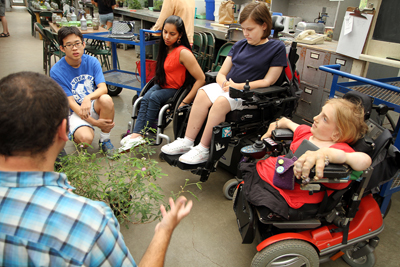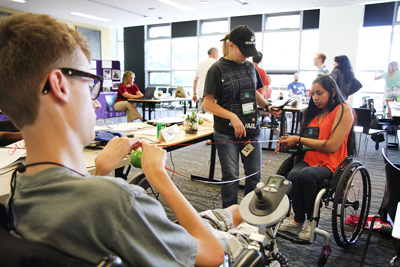The Thread: Disability in STEM Classes

I wanted to share with you a question posed by DO-IT Staff in our Internet discussion forum and some of the responses so that you can get the flavor of the many rich conversations the DO-IT community has online. This thread inspired the academic paper “Including Universal Design in Engineering Courses to Attract Diverse Students,” presented at the American Society for Engineering Education Annual Conference and Exposition. Forum posts are edited for clarity and brevity.
What, if anything, have you learned in your science, technology, engineering, and math (STEM) classes about disability or accessibility? How did you feel about it? If you haven’t had information about disability or accessibility in your classes, how do you think faculty members could have addressed one or both of these topics?
AccessSTEM Team Member: I never hear a word about disability in any of my classes. Instructors always put in the politically correct statements about disability accommodations but class content never includes disability.
AccessSTEM Team Member: I have a feeling that there will be a consensus for many of us that disability rights, accessibility, awareness, or even knowledge of disabilities are not being taught in our STEM related fields. This makes it our responsibility to educate faculty, so they can learn how to interact with students with disabilities and provide accessible assignments. We need to lay the foundation for future students with disabilities to be seen as equals and not just minorities.
AccessSTEM Team Member: In one of my graduate classes, my professor let me teach the entire class period about assistive technology. Jon Sanford, the director of the Center for Assistive Technology and Environmental Access on our campus, even got the school to pay for a vendor to complete a universal design assessment of our entire campus. We have a class on web accessibility, and I guest lecture on assistive technology for the prosthetics program. However, I know most professors have very little knowledge on how to work with people with disabilities. This is why a lot of the burden falls on the part of the student. I was the first totally blind student at my school, and I hope I am paving the way for other students with disabilities.
AccessSTEM Team Member: I learned nothing about disability or accessibility in my STEM classes. I was always the one to bring it up. I had some final projects in grad school where it was important to me to create accessible materials, but faculty or my classmates often thought I was being ridiculous. I think the reason for many accessibility-related issues in today’s technology is because accessibility isn’t taught in academia. If it isn’t taught, folks continue to create new inaccessible products.
DO-IT Ambassador: None of my classes have taught about accessibility, and my school seems opposed to becoming accessible. None of my textbooks were accessible until weeks into class, and the programs I needed to do math online or program were inaccessible. The school did nothing to address these issues. They actually told me to consider leaving and going to another college.

It sounds like there is very little discussion about disability in STEM curriculum. We have discussed encouraging engineering and computer design courses to include a unit on designing accessible products. Would you be interested in seeing this sort of information in a course?
DO-IT Ambassador: I would be interested in seeing information on accessibility in a course. There are multiple places where it could be applied. In a programming course that teaches Java or HTML, there could be a unit on how to write accessible software applications and web pages. Math and science books could include instructions on accessible ways to represent equations and a chart on keyboard commands for representing math symbols in Word.
AccessSTEM Team Member: It really should be a part of all STEM courses because that is where it will reach the greatest number of students and have the largest impact.
AccessSTEM Team Member: If it is not taught at the design level, people will never learn it.
AccessSTEM Team Member: As a computer science major at Stanford, I have generally found most professors to be understanding, and most will go out of their way to make sure I have the technology I need. We have an engineering class dedicated to assistive technologies, which satisfies a number of engineering requirements. Stanford also offers a class called “Social Perspectives on Disability.” However, I definitely think there is always room for improvement, and a lot of teachers still use inaccessible technology and documents.
DO-IT Scholar: When I was in high school, I had more science-based STEM classes, including a biotechnology class. Disability was mentioned, but the instructors always focused on the medical model of disability, which focused on curing people to make them “normal.”
AccessSTEM Team Member: I know my college offers accessible technology training webinars, but I don’t know how many professors take them. I think adding AT to the school’s curriculum would be an excellent way of assuring future educators and students are knowledgeable on the subject.
DO-IT Scholar: If disability gets included in the curriculum, my overall concern is the portrayal of it. People often seem to exaggerate or poorly portray disability, and if professors base their knowledge off of media sources, I’m afraid stereotypes may become worse.
DO-IT Ambassador: I agree that teachers need to be careful how they portray disabilities—I don’t want students pitying people with disabilities, just becoming more aware of accessibility.
DO-IT Scholar: I’d like to see more awareness, positive attitudes, and accessible information about disabilities as they pertain to technology. What bothers me about accessible design is that people with disabilities are rarely consulted or considered. There is not enough disability awareness within scholarly fields or the general public.